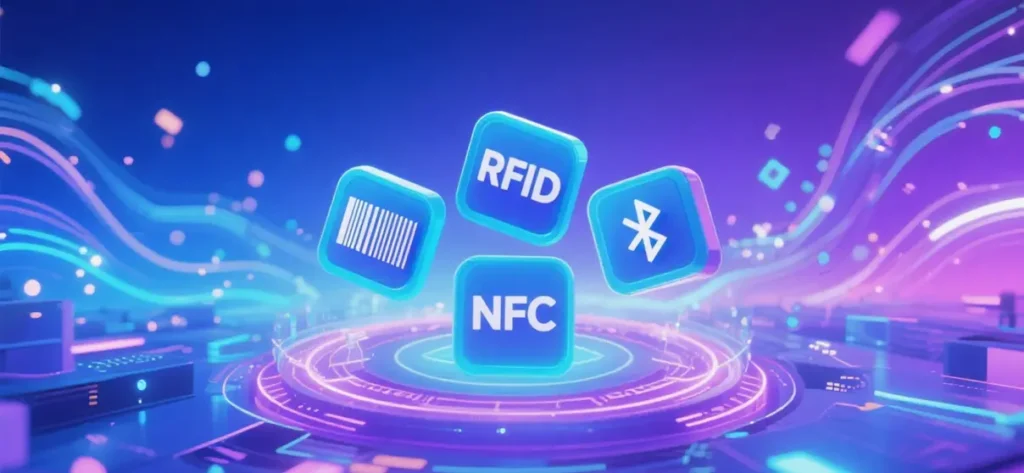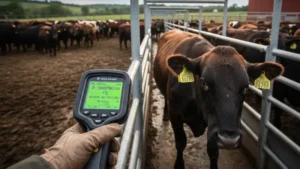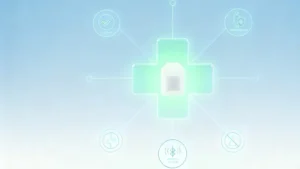
RFID vs. Barcode vs. NFC vs. Bluetooth: What’s the Difference?
Custom Your RFID Cards
In today’s rapidly evolving technological world, businesses and consumers alike can’t do without a variety of identification and tracking technologies to optimize processes, manage inventory or enhance convenience. However, with RFID, barcode, NFC, and Bluetooth – all seemingly similar technologies with different characteristics – many people are often confused: what are the differences? What scenarios are they suitable for? In this article, we will analyze the core differences between these four mainstream technologies in an easy-to-understand way, so as to help you make a wise choice according to your needs.
| Feature | Barcodes | RFID | NFC | Bluetooth |
| Technology Type | Optical (laser/camera scanning) | Radio frequency (passive/active tags) | Short-range radio frequency | Short-range wireless communication |
| Range | Inches (line-of-sight) | Inches to 100+ feet | < 4 cm (touch/near-touch) | 10–150 meters (Bluetooth 5.0+) |
| Data Capacity | 20–30 characters | Up to 2 KB (passive tags) | Up to 4 KB | Unlimited (supports large files) |
| Read Speed | Single tag per scan | Batch reading (100s of tags) | Single tag (fast touch) | Continuous streaming |
| Cost per Tag | 0.001–0.05 | 0.05–0.3 (passive) | 0.10–1.00 | N/A (device-based) |
| Power Source | None (printed labels) | Passive (reader-powered) or active (battery) | Passive (reader-powered) | Battery-powered devices |
| Security | Low (visible, easy to copy) | Medium (encryption available) | High (supports encryption) | Medium (pairing required) |
| Durability | Prone to damage (paper labels) | Resistant to dirt/water | Similar to RFID | Dependent on device |
| Best For |
Retail checkout |
Warehouse inventory – Asset tracking – Access control |
Mobile payments – Smart posters – Product authentication |
Wireless audio – Smart home devices – Fitness trackers |
| Key Limitation |
Line-of-sight required – No rewriting |
Metal/liquid interference – Higher cost |
Ultra-short range – Limited device compatibility |
Higher power consumption – Setup complexity |
Barcode: The Most Basic “Visual Labeling”
Barcode is the earliest popular automatic identification technology, encoding information through the width and spacing of black and white stripes. The principle is simple and straightforward: a laser scanner or camera reads the pattern of stripes and decoding software converts the pattern into numbers or letters.
- Advantages:
- Very low cost (a few cents for a label)
- Mature technology
- High compatibility (supports almost all retail systems)
- Limitations:
- Requires “face-to-face” scanning (within a few inches)
- Can only read one label at a time
- Limited data storage (20–30 characters typically)
- Typical Scenarios:
- Supermarket checkout
- Library book management
- Courier parcel sorting
RFID: Wireless Identification “Multi-Faceted”
RFID (Radio Frequency Identification) through radio waves to transmit data, without direct contact or alignment scanning. The system consists of tags (including chips and antennas) and read-write components, tags can be passive (no batteries, relying on read-write energy to activate) or active (with batteries) work.
- Advantages:
- Batch reading (scans hundreds of tags at once)
- Long-distance identification (inches to tens of meters)
- Repeatable data read/write
- Limitations:
- Higher tag cost (passive: ~$0.05–0.3; active: pricier)
- Metal/liquid environments interfere with signals
- Privacy risks (unauthorized reading)
- Typical Scenarios:
- Warehousing logistics tracking
- Smart shelf management
- Access control systems
- Pet chips
NFC: A Short-Range “Smart Bridge”
NFC (Near Field Communication) is essentially a high-frequency variant of RFID, but is designed for short-range (usually within 4 cm), two-way communication. It allows a device (such as a cell phone) to “touch” a tag or other NFC device to exchange data.
- Advantages:
- Minimal operation (approach/touch)
- High security (encryption support)
- Two-way communication (e.g., phone reads tag and returns information)
- Limitations:
- Extremely short range
- Slow transmission (suitable for small data)
- Device compatibility depends on NFC chips (old phones may lack support)
- Typical Scenarios:
- Mobile payment (Apple Pay/Google Pay)
- Public transportation cards
- Smart posters (touch for links)
- Product anti-counterfeiting verification
Bluetooth: Long-Distance “Wireless Ties”
Bluetooth is a short-range wireless communication technology (typical range of 10 meters, Bluetooth 5.0 up to 150 meters), through the frequency band hopping to achieve a stable connection between devices. Unlike the previous three technologies, Bluetooth focuses on continuous two-way communication rather than simple identification.
- Advantages:
- Wide coverage
- Supports complex data (audio/video)
- Multi-device connectivity (headsets, smartwatches, etc.)
- Limitations:
- Higher power consumption (needs batteries/charging)
- Complex setup (requires pairing)
- Higher cost than barcode/RFID tags
- Typical Scenarios:
- Wireless headphones
- Smart home devices (e.g., smart light bulbs)
- Fitness trackers
- In-car audio systems
How to Choose? The Key Depends on the Needs!
- Low-cost, large-scale identification → barcode (e.g., supermarket goods)
- Long-range, bulk tracking → RFID (e.g., warehouse goods)
- Fast, secure interaction → NFC (e.g., mobile payment)
- Ongoing, complex communication → Bluetooth (e.g., wireless headset)
Summary
There is no superiority or inferiority of the technology, and applicability is the king’s road.
Barcode, RFID, NFC, and Bluetooth are not competing, but rather complementary tools. For example, a retail store might simultaneously use bar codes at checkout, RFID cards to manage inventory, NFC to provide touch discounts, and Bluetooth to connect to register equipment. Understanding their differences allows technology to truly serve efficiency and innovation. The next time you’re faced with a choice dilemma, ask yourself:
- How much distance do I need?
- How much data?
- What’s the budget?
The answers will clarify the best choice!


